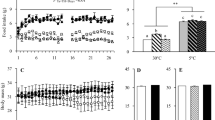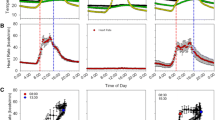Summary
The effect of photoperiod and melatonin treatment on cold resistance and thermogenesis of quails was studied. The birds were acclimated for 8 weeks to short day (8L:16D) or long day (16L:8D) conditions, and 8 of 16 quails in each group were implanted with melatonin capsules. One group of quails was maintained outside in an aviary during winter. Oxygen consumption (\(\dot V_{O_2 } \)) body temperature (T b, recorded with temperature transmitters) and shivering (integrated pectoral EMG) were recorded continuously, and samples of heart rate and breathing rate were picked up when ambient temperature was decreased stepwise from 27 down to −75 °C. Heat production maximum (HPmax), cold limit, lower critical temperature, basal metabolic rate (BMR) and thermal conductance were determined.
The results show that short day, cold and melatonin treatment improved cold resistance and thermal insulation of quils when compared with quails acclimated to long day conditions. An increase in HPmax was induced only by melatonin treatment. The results suggest that the acclimatization of quails is under control of the pineal gland.
The linear increase of shivering intensity with\(\dot V_{O_2 } \) at moderate cold load shows that shivering is the primary source for thermoregulatory heat production in the quail. AtT a's below −40 °C shivering remained constant although\(\dot V_{O_2 } \), heart rate and breathing rate continued to increase with increasing cold load. This could indicate the existence of a nonshivering thermogenesis in birds. Unlike to mammals, this non-shivering thermogenesis in birds would serve as secondary source of heat supporting shivering thermogenesis in severe cold
Similar content being viewed by others
Abbreviations
- BMR:
-
basal metabolic rate
- ECG:
-
electrocardiogram
- EMG:
-
electromyogram
- NST:
-
nonshivering thermogenesis
- SMR:
-
standard metabolic rate
References
Binkley SA, Kluth E, Menaker M (1971) Pineal function in sparrows: circadian rhythms and body temperature. Science 174:311–314
Böckler H, Heldmaier G (1983) Interaction of shivering and non-shivering thermogenesis during cold exposure in seasonally-acclimatized Djungarian hamsters (Phodopus sungorus). J Thermal Biol 8:97–98
Calder WA, King JR (1974) Thermal and caloric relations of birds. In: Farner DS, King JR (eds) Avian Biology, vol IV. Academic Press, New York, London, pp 259–413
Carey C, Dawson WR, Maxwell LC, Faulkner JA (1978) Seasonal acclimatization to temperature in cardueline finches. II. Changes in body composition and mass in relation to season and acute cold stress. J Comp Physiol 125:101–113
Challiss RA, Arch JRS, Newsholme EA (1984) The rate of substrate cycling between fructose 6-phosphate and fructose 1,6-biphosphate in skeletal muscle. Biochem J 211:153–161
Cogburn LA, Harrison PC, Brown DE (1976) Scotophasedependent thermoregulatory dysfunction in pinealectomized chickens. Proc Soc Exp Biol Med 153:197–201
Cogburn LA, Harrison PC, Blasbaugh BK (1979) Temperature preferendum of pinealectomized cockerels during their lightdark cycle. Proc. Soc. Exp Biol Med 161:425–429
Dawson WR, Carey C (1976) Seasonal acclimatization to temperature in cardueline finches. I. Insulative and metabolic adjustments. J Comp Physiol 112:317–333
George JC (1982) Thermogenesis in the avian body and the role of the pineal in thermoregulation. In: Reiter RJ, (ed) The Pineal and its Hormones. AR Liss, New York, pp 217–231
Haim A, Saarela S, Hissa R (1979a) Heat production induced by photoperiodicity in the pigeon. Comp Biochem Physiol 63A:547–549
Haim A, Saarela S, Hissa R (1979b) Photoperiodicity and the thermoregulatory response to noradrenaline in the pigeon. J Thermal Biol 4:167–171
Hart JS (1962) Seasonal acclimatization in four species of small wild birds. Physiol Zool 35:224–236
Heldmaier G, Hoffmann K (1974) Melatonin stimulates growth of brown adipose tissue. Nature 247:224–225
Heldmaier G (1975) The effect of short daily cold exposure on development of brown adipose tissue in mice. J Comp Physiol 98:161–168
Heldmaier G, Steinlechner S (1981) Seasonal control of energy requirements for thermoregulation in the Djungarian hamster (Phodopus sungorus), living in natural photoperiod. J Comp Physiol 142:429–437
Heldmaier G, Steinlechner S, Rafael J, Vsiansky P (1981) Photoperiodic control and effects of melatonin on nonshivering thermogenesis and brown adipose tissue. Science 212:917–919
Heidmaier G, Steinlechner S, Rafael J (1982) Nonshivering thermogenesis and cold resistance during seasonal acclimatization in the Djungarian hamster. J Comp Physiol 149:1–9
Hochachka PW (1974) Regulation of heat production at the cellular level. Fed Proc 33:162–169
Hohtola E (1982) Thermal and electromyographic correlates of shivering thermogenesis in the pigeon. Comp Biochem Physiol 73A:159–166
John JM, Itoh S, George JC (1978) On the role of the pineal in thermoregulation in the pigeon. Horm Res 9:41–56
Johnston DW (1971) The absence of brown adipose tissue in birds. Comp Biochem Physiol 40:1107–1108
Klussmann FW (1969) Influence of temperature upon the afferent and efferent motor innervation of the spinal cord. I. Changes of afferent and efferent spontaneous activity with spinal temperature. Pflüger's Arch 305:295–315
Lustick S, Adams J (1977) Seasonal variation in the effect of wetting on the energetics and survival of starlings (Sturnus vulgaris). Comp Biochem Physiol 56A:173–177
Menaker M, Hudson DJ, Takahashi J (1981) Neural and endocrine components of circadian clocks in birds. In: Follett BK, Follett DE (eds) Biological Clocks in Seasonal Reportduction Cycles. Wright, Bristol, pp 171–183
Newsholme EA, Crabtree B, Higgins SJ, Thornton SD, Start C (1972) The activities of fructose diphosphatase in flight muscles from the bumble-bee and the role of this enzyme in heat generation. Biochem J 128:89–97
Oliphant LW (1983) First observation of brown fat in birds. Condor 85:350–354
Ralph CL (1984) Pineal bodies and thermoregulation. In: Reiter RJ (ed) The Pineal Gland. Raven Press, New York, pp 193–219
Saarela S (1980) Sympathetic regulation of body temperature in birds. Acta Univ Oul A 100:Biol. 8
Saarela S, Vakkuri O (1982) Photoperiod-induced changes in temperature-metabolism curve shivering threshold and body temperature in the pigeon. Experientia 38:373–374
Saarela S, Rintamäki H, Saarela M (1984) Seasonal variation in the dynamics of ptiloerection and shivering correlated changes in the metabolic rate and body temperature of the pigeon. J Comp Physiol 154:47–53
Scholander PF, Hock R, Walters V, Irving L (1950) Adaptation to cold in arctic and tropical mammals and birds in relation to body temperature, insulation and basal metabolic rate. Biol Bull 99:259–271
Simpson SM, Follett BK (1981) Pineal and hypothalamic pacemakers: their role in regulating circadian rhythmicity in Japanese quail. J Comp Physiol 144:381–389
Slonim AD (1971) Eco-physiological patterns of thermoregulation and the shivering thermogenesis. J Physiol 63:418–420
Spaan G, Klussmann FW (1970) Die Frequenz des Kältezitterns bei Tierarten verschiedener Größe. Pflüger's Arch 320:318–333
Stemlechner S, Heldmaier G (1982) Role of photoperiod and melatonin in seasonal acclimatization of the Djungarian hamster,Phodopus sungorus. Int J Biometeor 26:329–337
Stevens DE, Ferguson J, Thomas VG, Hohtola E (1986) Contribution of shivering in leg muscles to heat production in Japanese quail Can J Zool 64:889–892
Turek FW, McMillan JP, Menaker M (1976) Melatonin: Effects on the circadian locomotor rhythm of sparrows. Science 194:1441–1443
Vakkuri O, Leppäluoto J, Vuolteenaho O (1984) Development and validation of a melatonin radioimmunoassay using radioiodinated melatonin as tracer. Acta Endocrinol 106:152–157
Viitasalo J, Komi P (1977) Signal characteristics of EMG during fatigue. Eur J Appl Physiol 37:111–121
West GC (1965) Shivering and heat production in wild birds. Physiol Zool 38:111–120
Author information
Authors and Affiliations
Rights and permissions
About this article
Cite this article
Saarela, S., Heldmaier, G. Effect of photoperiod and melatonin on cold resistance, thermoregulation and shivering/nonshivering thermogenesis in Japanese quail. J Comp Physiol B 157, 625–633 (1987). https://doi.org/10.1007/BF00700983
Accepted:
Issue Date:
DOI: https://doi.org/10.1007/BF00700983




